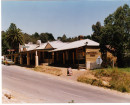TALISKER HOMESTEAD COMPLEX
221 TALISKER HOMESTEAD ROAD, MERINO, GLENELG SHIRE
-
Add to tour
You must log in to do that.
-
Share
-
Shortlist place
You must log in to do that.
- Download report



Statement of Significance
Talisker Homestead Complex, Talisker Homestead Road, Merino was built for the grazier, Alexander Magnus McLeod (1846-1910) and his wife Caroline in 1901. Talisker was a sub-division of Merino Downs, one of the first three squatting runs in Victoria. Francis Henty (1815-1889), a Sussex sheep farmer then based in Portland with his father and brothers had established the run by August 1837, a year after Major Thomas Mitchell had told the Hentys about the excellent country he had discovered on his expedition from Sydney to the mouth of the Glenelg. After Francis' death, Merino Downs was divided into three Estates, one for each of his three daughters, Louisa, Caroline and Alice. Caroline Henty (1849-1914) became the owner of Talisker. She married A.M. McLeod and they lived there from 1901 until his death there in 1910. She continued there until her death at Talisker in 1914. Mrs K. McWhae, Caroline's daughter, owned Talisker after her mother's death until the Second World War years. In c1946/47, A.N. Silvester bought back the homestead block. The Silvesters had been McLeod family solicitors over a number of years and the families had intermarried. The Silvester family owned Talisker Homestead until the sale of the property in c1970 to its present owner. There were many links over many years between Talisker, Merino Downs, Castlemaddie and Mount Clay, all important early pastoral properties although Talisker was the grandest. For example, Hugh Vernon McLeod, nephew of A.M. McLeod and his wife, the former Caroline Henty, was at one time overseer at Merino Downs. The links between Talisker, Castlemaddie and Mount Clay related to McLeod family connexions. After his uncle's death in 1889, Hugh Vernon McLeod managed Talisker for his aunt Caroline. In 1920, Hugh Vernon bought back Castlemaddie, originally owned in the 1850s by his grandfather, J.N. McLeod (1816-1886).
A.M. and Caroline McLeod commissioned Charles D'Ebro (1850-1920), to design the new homestead. Born in London and trained as an engineer, D'Ebro became a successful, well-connected and fashionable Melbourne architect with a practice which extended to other Australian states and to New Zealand. He had already designed Northbrook, Malvern, c.1888 for Donald Munro, son of the Victorian Premier and Stonnington, Malvern after 1886 for John Wagner, owner of Cobb & Co. coaches and a successful gold mining entrepreneur. He also designed the Prahran Town Hall and the Prahran Municipal Market. For a short time D'Ebro was in partnership with John Grainger and John Shanks Jenkins, both architects and engineers, when he was associated with the construction of the present Princes Bridge, Melbourne. Jenkins had direct personal and professional connections with the Western District, particularly in and around Hamilton. Jenkins, who by 1901 was aged 67, may have influenced the commissioning of Talisker. Stephen Henty, brother of Francis Henty and uncle of Caroline McLeod, had commissioned Jenkins to design his new homestead Warrayure at Strathkellar near Hamilton in 1860.
D'Ebro's design for Talisker was at the same time very daring in its confident use of strong details and bold forms but conventional in its planning, with a strict hierarchy of rooms and practical separation of people and functions. It is an individual interpretation of the Federation style although with many standard details for the period, such as the coloured leadlight, elaborate plasterwork, handsome timber mantelpieces and stained joinery, especially for the main staircase. It is a gentleman's country house, a very late example of a villa in the landscape. The dramatic siting of the house takes full advantage of the prospect over the whole of the original Merino Downs Estate seen from the dominating viewing tower. The house is also sited to be seen. The grounds supported the house, formerly including a decorative pleasure garden immediately to the front and side, an orchard to the north and a 'wild' garden to the south. Talisker can be compared with D'Ebro's earlier designs for Stonnington, which is heavily Classical and Langi Willi at Skipton, for George Russell which adopts a more conservative interpretation of the Queen Anne/Arts and Crafts house. It can also be compared with the lighter design for Purrumbete at Camperdown by Guyon Purchas for the Manifold Family and the similar but smaller Mount Koroite Homestead at Coleraine, for J.F. Kirby supposedly on the winnings of the 1911 Melbourne Cup, which has not yet been attributed to any architect.
The homestead at Talisker remains significantly intact. The interiors are particularly intact with some original wallpapers surviving and all of the extensive original joinery still stained and polished. Only minor changes have been made to the service areas. The house is in good condition. The garden is reduced but it also retains important original plantings including: two Araucaria bidwillii, Bunya Bunya pines in the drive; a Prunus dulcis, Almond tree in the front garden; a Brachychiton acerfolius, Kurrajong in the side garden; a Quercus robur, English Oak and a Corymbia ficifolia, Red Flowering Gum in the rear garden; and all of the mature plantings in the wild garden and the orchard. Its original layout including the drive, various compartments and small works, is easily discernable. The outbuildings also survive well.
How is it Significant?
Talisker Homestead Complex is of historical, social and architectural significance to the State of Victoria.
Why is it Significant
The Talisker Homestead Complex has historical and social significance as a fine example of a residence, garden and supporting outbuildings established by a member of a major Western District pioneer pastoral family and for demonstrating their success and position in society. Through his marriage to Caroline Henty in 1890, A.M. McLeod formed an association with the Hentys, the family generally acknowledged as the founders of Victoria. The site of Talisker has historical significance as originally part of the very early Merino Downs, one of the first three squatting runs established by the Henty family. Talisker Homestead also has historical significance for its long association with the McLeod family and its descendants. It has social significance for its association with a number of other important Glenelg Shire pastoral properties as a result of family links between the Henty and McLeod families. The homestead complex demonstrates through the hierarchy and separation of rooms, the surrounding garden used for both pleasure and production and the outbuildings, a lifestyle now long passed.
Talisker Homestead, a substantial brick residence in the Federation style with a distinctive domed tower, a district landmark, has architectural significance as an important example of an Australian country home designed by the notable Victorian architect, Charles D'Ebro. It compares well with D'Ebro's other domestic work and with homesteads of the same period and pretension across Victoria. It is a very late example of a villa set in a landscape claimed by the owners. It can be contrasted with Muntham, the only surviving Henty homestead from the earliest phase of squatting.
-
-
TALISKER HOMESTEAD COMPLEX - Usage/Former Usage
Continues as a pastoral property and residence
TALISKER HOMESTEAD COMPLEX - Physical Description 1
Talisker was built for Alexander Magnus and Caroline Macleod and designed by Melbourne architect Charles D'Ebro in 1901. Importantly, the original drawings survive and are held in the State Library (SLV, Architectural Drawings collection, Residences, Acc No. H91.148/1, H92.148/2). Two early photographs of Talisker exist showing the front elevation and a view from the side showing the back elevation across the homestead to a valley beyond (SLV, Acc. No. H91.148/3, H91.148/4).
Talisker is a large single storey Edwardian homestead of 'Ballarat black' bricks with red brick bands and a corrugated metal roof. The bricks are believed to have been railed to Merino and then hauled to the site by bullock dray (John McIntosh, pers. comm., 11/10.06). The facade is highly embellished with Edwardian architectural elements including a timber posted verandah, gables, banded brickwork and tuck-pointing. Over the front door, there is a crest with a bull's head set between two flags and a banner with the motto 'Hold Fast' and the name 'Talisker'. By contrast, the rear of the "U" shaped plan is unadorned apart from the device of placing three windows together in the wall. The whole composition of the building is dominated by a massive three-level tower, including a room on the first floor with a large Elizabethan style box window, and an open balcony on the second floor. The roof of the tower is double-curved, and is supported on turned timber columns. The tower is an Edwardian equivalent of the tall slender tower on Narrapumelap at Skipton. It is designed to allow an elevated view of the property below and is intended as much to be seen from a distance.
Talisker has a fairly typical homestead form from the nineteenth century with a long verandah to the front elevation. This is overlaid with Edwardian building elements such as gable ends decorated with timber strapping, substantial timber posts, capitals and friezes. The most unusual elements are the large bay window with brick parapet that extends through the roof and the tower. The plan separates the various functions of the household and the people who lived and worked there. 'The house, when completed, covered eighty-six squares [approximately 860m2] and comprised twenty-five rooms in three wings. The section designed for the servants' quarters, contained two maid's rooms, a large kitchen, laundry, meat room, a cream room with its huge slate topped benches and fly proofed safes, a scullery, servery, pantry and a cellar' (Leake, pp. 45).
The interior is finely crafted with extensive use of timber joinery and plaster cornice decoration. The front door and sidelights are of decorative coloured leadlight glass and the joinery appears to be either polished or wood grained. The stair spandrel is panelled and the handrail and balusters of polished timber. Some doors have an unusual panelled detailing. There is an art nouveau inspired painted frieze to at least one room, and some ceilings are of polished timber. The exterior and interior of Talisker are in excellent condition and the architectural details appear to be intact in the main rooms.
Talisker may be compared with Charles D'Ebro's other large homestead commission of Langi Willi built in 1893, the architectural drawings for which also survive (SLV, Acc No. H37688/1-10). Langi Willi is a picturesque composition including a mock castellated tower, an Elizabethan window similar to the one at Talisker and Arts and Crafts roof forms. By comparison, Talisker is a more modest example of the Edwardian style in a traditional homestead plan. It can also be compared with contemporary homesteads designed or remodelled by other leading architects. The similar but smaller Mount Koroite Homestead at Coleraine, which was remodelled for J.F. Kirby supposedly on the winnings of the 1911 Melbourne Cup, has not yet been attributed to any architect. The architect, Guyon Purchas remodelled Purrumbete at Camperdown in 1901 for the Manifold family. The interiors of Purrumbete are more richly Art Nouveau with Robert Prentzel carvings featuring Australian motifs and Walter Withers murals depicting the history of the Manifolds. Prentzel carvings also contribute to the interiors of Glenormiston, remodelled in 1908 for the Black family but its exterior is a late interpretation of the Italianate style. Other Western district homesteads include Ettrick at Derrinallum and Woolongoon at Mortlake.
The homestead is approached by a sweeping drive and enhanced by its garden. Two mature Araucaria Bidwillii (Bunya Bunya pines) survive as a pair half way along the drive. The garden is compartmentalised in the conventional manner. The front garden is laid out formally with a large circular bed and path at its centre. It overlooks the valleys of Miakite or Henty Creek and Tea Tree Creek towards a vast pastoral landscape in all directions. A Prunus dulcis, (Almond) tree survives at the north-west corner of the homestead. To the north west of the main homestead, on a slope, there are the remnants of an extensive orchard. This was once part of a much larger subsistence garden, with vegetable beds. There are a number of smaller trees immediately to the north of the house, in particular, a fine example of Brachychiton acerfolius (Kurrajong). To the south there is a 'wild' garden. It contains many original plantings now mature, if not senescent including many different types of Prunus spp. and Crataegus spp., an Araucaria bidwillii (Bunya Bunya Pine), Washingtonia filifera, as well as many bulbs and shrubs. Unfortunately, this area has fallen into disrepair and many of the fine specimen trees, such as the Araucaria bidwillii and the Washingtonia filifera are now in demise. The wild garden extends some 600m down the hill, overlooking the Wurt Wurt Creek valley. The wild garden appears to date from the 1920s, whereas the rest of the garden and most of the significant trees probably date from the same time as the main homestead. The rear garden is a plain service yard, with an underground well, but it does include two significant mature trees, a Quercus robur (English Oak) and a Corymbia ficifolia (Red Flowering Gum).TALISKER HOMESTEAD COMPLEX - Physical Conditions
Very Good
TALISKER HOMESTEAD COMPLEX - Historical Australian Themes
3 Developing local, regional and national economies
3.5 Developing primary production
3.5.1 Grazing stock
3.5.3 Developing agricultural industries
5 Working
5.8 Working on the land
8 Developing Australia's Cultural Life
8.10 Pursuing excellence in the arts and sciences
8.10.3 Designing and building fine buildingsHeritage Study and Grading
Glenelg - Glenelg Shire Heritage Study Part One
Author: Carlotta Kellaway, David Rhodes Mandy Jean
Year: 2002
Grading:Glenelg - Glenelg Heritage Study Stage Two (a)
Author: Heritage Matters
Year: 2006
Grading:
-
-
-
-
-
TALISKER HOMESTEAD COMPLEX
 Glenelg Shire
Glenelg Shire
-
'Mororo' 13 Oxford Street, Malvern
 Stonnington City
Stonnington City -
1 Arnold Street
 Yarra City
Yarra City -
1 Austin Street
 Yarra City
Yarra City
-
-










